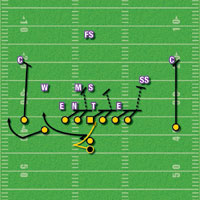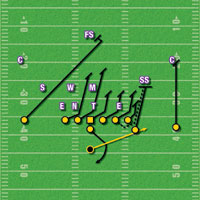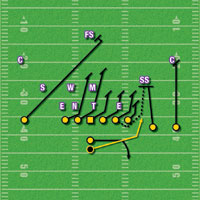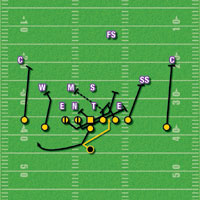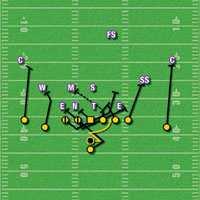AMERICAN FOOTBALL MONTHLY THE #1 RESOURCE FOR FOOTBALL COACHES
Article CategoriesAFM Magazine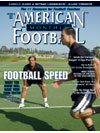
|
The Pistol OffenseMaking the transition from the single back offense.by: Steve Rampy Head Coach, Blue Valley High School, Stilwell, KS © More from this issue For the past twenty-five years, I have coordinated the offense at Blue Valley High School. In all that time we have been either an ‘I’ offense or a single back offense. Making the transition from the single back/I offense under center to the Pistol offense in the shotgun has been much easier than we ever could have predicted. All the plays we ran in the I, we can run out of a Pistol alignment. Everything we ran in the single back look, we now do out of the Shotgun-Pistol. The greatest advantage is that you can do more. From the ‘I’ Formation to the Two Back Pistol When we were in the ‘I’ formation, we ran all the traditional plays – Fullback Iso, Fullback Kick Out, Toss Sweep, Counter Trey and Fullback Trap. We were a traditional ‘I’ team. Our offense was dependent upon having a good blocking fullback and an offensive line that could dominate the line of scrimmage. Those same plays can be run from the Pistol. When we add a fullback to our personnel, we have the ability to run all those plays plus our bread and butter play: the zone read, with either the A back or the B back being the zone runner. Fullback isolation and kickout become zone lead plays with the fullback leading on an extra defender in the box. Toss sweep becomes the stretch play with the fullback leading on the edge. We can also use that same scheme to run speed option. We run counter trap with the fullback being our second puller to lead up on a counter-action play. The difference and the advantage is zone read. That is a play that allows us to attack either the tight side or split side and outnumber the defense with option football. From the Single Back to the Pistol In 1991, we went exclusively to the single back offense. We took our fullback out of the game and inserted a third receiver. We felt this forced the defense to spread and defend the entire field. It gave us a great advantage in the passing game, but it limited what we could do in the running game. It was then that we simplified our running game to essentially three plays: the inside zone, outside zone (stretch) and counter trey. Those three schemes gave us all we needed to run the ball effectively after we spread the defense by formation. Those same three plays continue to be the foundation of our running game today in the Pistol offense. The best play we have is the zone read. We block it just like we did in 1991. The big difference is the ‘read’ part of the play. We now have the ability to attack a weak side when they pursue the ball too hard. We feel that it is ‘Spread Option Football’ out of the gun. The diagrams show the inside zone in a traditional offensive formation and our version of the zone read from the Pistol (See Diagrams 1 and 2).
Blocking Assignments (Diagram 1): BS Tackle: Zone block with BS guard on BS stack; must read BS LB's alignment. BS Guard: Zone block with BS tackle on BS stack; if uncovered, zone block with center. Center: Zone block with PS guard on PS stack; if covered, zone block with BS guard. PS Guard: Zone block with center on PS stack; if uncovered, zone block with PS tackle. PS Tackle: Zone block the 5 technique on PS. PS Receivers: Stalk block if zone; runoff if it's man coverage. Backside Outside Receiver: Stalk block C, if only two WRs; with three WRs, crack the FS. BS Inside Receiver: Push off of inside foot and bubble as deep as you need to but stay behind the LOS. Path of the bubble route is not as important as going full speed down hill when he catches the ball. (Some receivers may get as deep as eight or nine yards). Backside #3 Receiver: Arc release and block the corner. A back: Take one lateral step toward the QB, take the ball, read the first down linemen on PS. QB: Open to the A back, extend the ball and read BS center gap defender. If he chases, keep the ball.
Blocking Assignments (Diagram 2): BS Tackle: Zone block with BS guard on BS stack; must read BS LB’s alignment. BS Guard: Zone block with BS tackle on BS stack; if uncovered, zone block with center. Center: Zone block with PS guard on PS stack; if covered, zone block with BS guard. PS Guard: Zone block with center on PS stack; if uncovered, zone block with PS tackle. PS Tackle: Zone block the 5 technique on PS. PS Receivers: Stalk block if zone; runoff, if it's man coverage. Backside Outside Receiver: Stalk block center, if only two receivers; with three receivers, crack FS. BS Inside Receiver: Push off of inside foot and bubble as deep as you need to and stay behind the LOS. Path of the bubble route is not as important as going full speed down hill when he catches the ball. (Some receivers may get as deep as eight to nine yards). Backside #3 receiver: Arc release and block the corner. A back: Take one lateral step toward the QB, take ball, read the first down lineman on PS. QB: Open to the A back, extend the ball and read BS center gap defender. If he chases, keep the ball. We discovered that we could also run the stretch play when we went to the Pistol alignment. It is one of the advantages of the Pistol alignment over the traditional offset shotgun. The path of the A back is one yard outside the TE, just as it was when we were under center. We feel that this play puts great pressure on the defense to run outside. Once we get a defense running from side to side, we feel as though we have an advantage on offense in the passing game and inside zone. The techniques and schemes we use in blocking the stretch play are the same as we’ve used for the past 17 years. The diagrams below show Toss Sweep and Stretch from the Pistol. Notice the blocking for each is the same (See Diagrams 3 and 4).
Blocking Assignments (Diagram 3): BS Tackle: Clip the man over the BS guard; if you can cross his face, go to next level. BS Guard: Cut-off the BS LB to the FS; square pull to PS LB. Center: Fill for the PS guard; clip or try to cross his face to next level. PS Guard: Square pull and block the first force outside if uncovered; if covered, rip to the next level. PS Tackle: Square pull and block the first force outside if uncovered; if covered, rip to the next level. TE: Rip and run the DE to the PS; on the BS, rip and run to the next level. PS Receivers: Crack the first man inside off the ball, or go to FS. Backside receivers: Cut-off pursuit angle for BS defenders. A back: Try to outrun the QB, aiming at a point one yard outside the TE.
Blocking Assignments (Diagram 4): BS Tackle: Clip the man over the BS guard; if you can cross his face, go to next level. BS Guard: Cut-off the BS LB to the FS; square pull to PS LB. Center: Fill for the PS guard; clip or try to cross his face to next level. PS Guard: Square pull and block the first force outside if uncovered; if covered, rip to the next level. PS Tackle: Square pull and block the first force outside if uncovered; if covered, rip to the next level. TE: Rip and run the DE to the PS; on the BS, rip and run to the next level. PS Receivers: Cracks the first man inside off the ball, or go to FS. Backside receivers: Cut-off pursuit angle for BS defenders. A back: Try to outrun the QB, aiming at a point one yard outside the TE. QB: Open to the A back, extend the ball and carry out fake to weak side or drop back to pass. One of the greatest advantages of the shotgun Pistol offense is the misdirection of the QB counter. Our quarterback's running ability has been instrumental in our offensive success for the past three seasons. We block the QB counter just as we blocked the counter trey for the past 17 years (See Diagrams 5 and 6).
Blocking Assignments (Diagram 5): BS Tackle: Pull and turn up for the first LB inside. BS Guard: Block a 3 technique; pull and kick-out or log if covered by inside shade. Center: BS guard has a 3 technique, then pull and kickout or log; block back on shade. PS Guard: Zone block the man on to the BS LB with the PS tackle. PS Tackle: Zone block the man on the PS guard to the BS LB. PS Receivers: Both receivers stalk block the man-on. Backside Receivers: Cut-off pursuit angle for BS defenders. A back: Make a counter fake to the backside and fill for pulling tackle. QB: Fake to the A Back and follow pulling linemen.
Blocking Assignments (Diagram 6): BS Tackle: Pull and turn up for the first LB inside. BS Guard: Block a 3 technique; pull and kick-out or log if covered by inside shade. Center: BS guard has a 3 technique, then pull and kickout or log; block back on shade. PS Guard: Zone block the man on to the BS LB with the PS tackle. PS Tackle: Zone block the man on the PS guard to the BS LB. PS Receivers: Both wide receivers stalk block the man-on. Backside Receivers: Cut-off pursuit angle for BS defenders. A back: Make a counter fake to the backside and fill for pulling tackle. QB: Fake to the A Back and follow pulling linemen. Converting our offense to the Pistol has been the most enjoyable experience of my coaching career. Everything we’ve tried to do over the years, we now do in the Pistol alignment. I feel like we’ve only scratched the surface of what we can do in the Pistol. It will be exciting to explore where this offense takes us in the next few years. |
|
| HOME |
MAGAZINE |
SUBSCRIBE | ONLINE COLUMNISTS | COACHING VIDEOS |
Copyright 2024, AmericanFootballMonthly.com
All Rights Reserved



